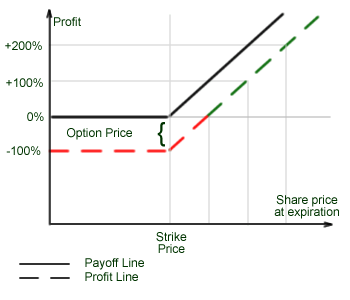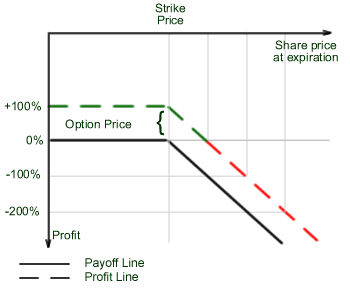Buying a call option ("a call") gives you the right, but not the obligation, to purchase an underlying security at a predetermined price for a certain time period. Call options are available in various strikes and expiration dates. Expiration dates very from as short as one month to as long as a year or more. You are betting that the underlying security will rise within the time that your option is valid, as a call options buyer. The amount you paid for the option, is the maximum risk you take by buying a call option; in other words, you cannot lose more than the premium you paid for the call. Depending on the price increase of the underlying security is the extent of you potential profit. The long call becomes more valuable, as it goes up, because you have paid for the right to buy the underlying security at a given strike price. That is the reason why traders buy call options in a rising or bull market.
Let's assume that a particular stock currently trades at $40. You can buy a call with an expiration date three months into the future and a strike price of $44. You paid $1 per contract for the right, but not the obligation, to buy 100 shares of the underlying stock for $44.
Now , what if the stock goes up to $50 within the next three months, (i.e., before the option is due to expire). By demanding from the call seller (the option "writer") that he or she sells the stock to you for $44, because now you can exercise your call option. Because you can sell the stock immediately at the current market price of $50, you have made a $6 (600%) profit, minus, of course, the cost of the option purchase.
If we assume the stock has declined to $35 by the time the option expires, on the other hand, it would not make sense to exercise the call and buy the stock for $44. You would let your option expire worthless, in this situation, and take a loss of $1 per contract. It is the seller of the call who will realize a profit of ($1 per contract) in this case.
A call option ("calls") is a financial contract between two parties, the calls buyer and the calls seller. The buyer of the call option has the right to buy the underlying assets (stock) from the seller of the option for a certain price (the strike price) and before or at a certain time (the expiration date).
The call options buyer expects the price of the underlying stock to rise in the future but before the options expiration. On the other hand call options seller expects the underlying stock to drop in price.
The call buyer profits when the underlying stock price moves up and looses when the stock drops in price. The maximum the options buyer can lose is the premium paid for options - 100% of the invested funds. The maximum potential profit the options buyer may achieve is theoretically unlimited.
The call seller profits when the underlying stock price declines and the maximum profit could be achieved when sold calls expire worthless - 100% of the premium received for calls. If the underlying stock price moves up the call seller experiences losses and the maximum loss is theoretically unlimited.
The call options are considered in-the money if the current stock price is above the strike price and the call options are considered out-of-the-money if the current stock price is below the strike price. At the expiration the in-the-money options are profitable and out-of-the-money options are worthless.
Chart 1. Buying a call option - the payoffs and profits as seen by the buyer. A higher stock price means a higher profit.
Chart 2. Selling a call option - the payoffs and profits as seen by the buyer. A higher stock price means a higher losses.
Majority of the options traders do not wait for expiration but rather sell previously bought calls and profit on the difference between the premium paid when calls were bought and premium received when calls were sold. By following the example above:
Naked options trading is very risky - many people lose money trading them. It is recommended contacting your broker or investment professional to find out about trading risk and margin requirements before getting involved into trading uncovered options.